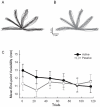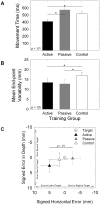The role of motor learning in spatial adaptation near a tool
- PMID: 22174944
- PMCID: PMC3236781
- DOI: 10.1371/journal.pone.0028999
The role of motor learning in spatial adaptation near a tool
Abstract
Some visual-tactile (bimodal) cells have visual receptive fields (vRFs) that overlap and extend moderately beyond the skin of the hand. Neurophysiological evidence suggests, however, that a vRF will grow to encompass a hand-held tool following active tool use but not after passive holding. Why does active tool use, and not passive holding, lead to spatial adaptation near a tool? We asked whether spatial adaptation could be the result of motor or visual experience with the tool, and we distinguished between these alternatives by isolating motor from visual experience with the tool. Participants learned to use a novel, weighted tool. The active training group received both motor and visual experience with the tool, the passive training group received visual experience with the tool, but no motor experience, and finally, a no-training control group received neither visual nor motor experience using the tool. After training, we used a cueing paradigm to measure how quickly participants detected targets, varying whether the tool was placed near or far from the target display. Only the active training group detected targets more quickly when the tool was placed near, rather than far, from the target display. This effect of tool location was not present for either the passive-training or control groups. These results suggest that motor learning influences how visual space around the tool is represented.
Conflict of interest statement
Figures





Similar articles
-
Optic flow improves adaptability of spatiotemporal characteristics during split-belt locomotor adaptation with tactile stimulation.Exp Brain Res. 2016 Feb;234(2):511-22. doi: 10.1007/s00221-015-4484-5. Epub 2015 Nov 2. Exp Brain Res. 2016. PMID: 26525712 Free PMC article.
-
Brain functional differences in visuo-motor task adaptation between dominant and non-dominant hand training.Exp Brain Res. 2019 Dec;237(12):3109-3121. doi: 10.1007/s00221-019-05653-5. Epub 2019 Sep 21. Exp Brain Res. 2019. PMID: 31542802
-
Investigating the role of response in spatial context learning.Q J Exp Psychol (Hove). 2011 Aug;64(8):1563-79. doi: 10.1080/17470218.2011.564291. Epub 2011 Jun 24. Q J Exp Psychol (Hove). 2011. PMID: 21480078
-
Object-guided spatial selection in touch without concurrent changes in the perceived location of the hands.Exp Psychol. 2013;60(1):64-70. doi: 10.1027/1618-3169/a000180. Exp Psychol. 2013. PMID: 23047917
-
Sensory motor remapping of space in human-machine interfaces.Prog Brain Res. 2011;191:45-64. doi: 10.1016/B978-0-444-53752-2.00014-X. Prog Brain Res. 2011. PMID: 21741543 Free PMC article. Review.
Cited by
-
Can proprioceptive training improve motor learning?J Neurophysiol. 2012 Dec;108(12):3313-21. doi: 10.1152/jn.00122.2012. Epub 2012 Sep 12. J Neurophysiol. 2012. PMID: 22972960 Free PMC article. Clinical Trial.
-
To the end! Distribution of attention along a tool in peri- and extrapersonal space.Exp Brain Res. 2013 Jun;227(4):423-32. doi: 10.1007/s00221-013-3439-y. Epub 2013 May 28. Exp Brain Res. 2013. PMID: 23712683 Clinical Trial.
-
Haptic over visual information in the distribution of visual attention after tool-use in near and far space.Exp Brain Res. 2015 Oct;233(10):2977-88. doi: 10.1007/s00221-015-4368-8. Epub 2015 Jul 1. Exp Brain Res. 2015. PMID: 26126805
-
A touchy subject: advancing the modulated visual pathways account of altered vision near the hand.Transl Neurosci. 2014 Nov 7;6(1):1-7. doi: 10.1515/tnsci-2015-0001. eCollection 2015. Transl Neurosci. 2014. PMID: 28123785 Free PMC article. Review.
-
Exogenous and endogenous shifts of attention in perihand space.Psychol Res. 2016 Jul;80(4):677-84. doi: 10.1007/s00426-015-0680-y. Epub 2015 Jul 2. Psychol Res. 2016. PMID: 26134543
References
-
- Iriki M, Tanaka M, Iwamura Y. Coding of modified body schema during tool use by macaque postcentral neurones. Neuroreport. 1996;7:2325–2330. - PubMed
-
- von Helmholtz H. New York NY: Dover; 1962. Handbook of Physiological Optics.
-
- Von Holst E, Mittelstaedt H. Martin RD, editor. The reafference principle. Interaction between the central nervous system and the periphery. The Behavioral Physiology of Animals and Man: Selected Papers of E von Holst, Vol 1. Coral Gables FL: University of Miami. 1950.
-
- Fogassi L, Gallese V, Fadiga L, Luppino G, Matelli M, et al. Coding of peripersonal space in inferior premotor cortex (area F4). J Neurophysiol. 1996;76:141–157. - PubMed
-
- Graziano MSA, Gandhi S. Location of the polysensory zone in the precentral gyrus of anesthetized monkeys. Exp Brain Res. 2000;135:259–266. - PubMed
Publication types
MeSH terms
LinkOut - more resources
Full Text Sources

